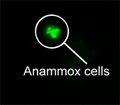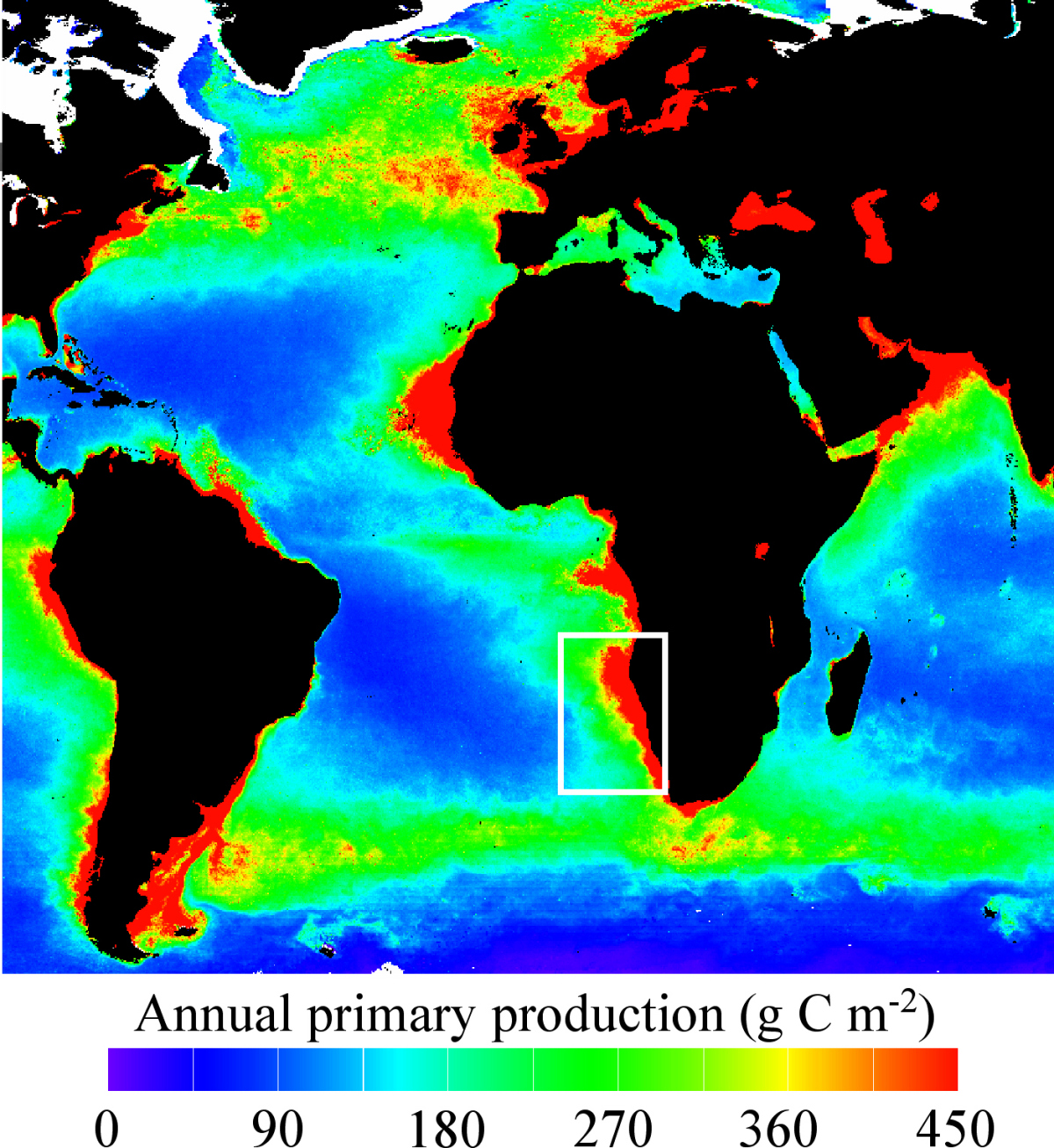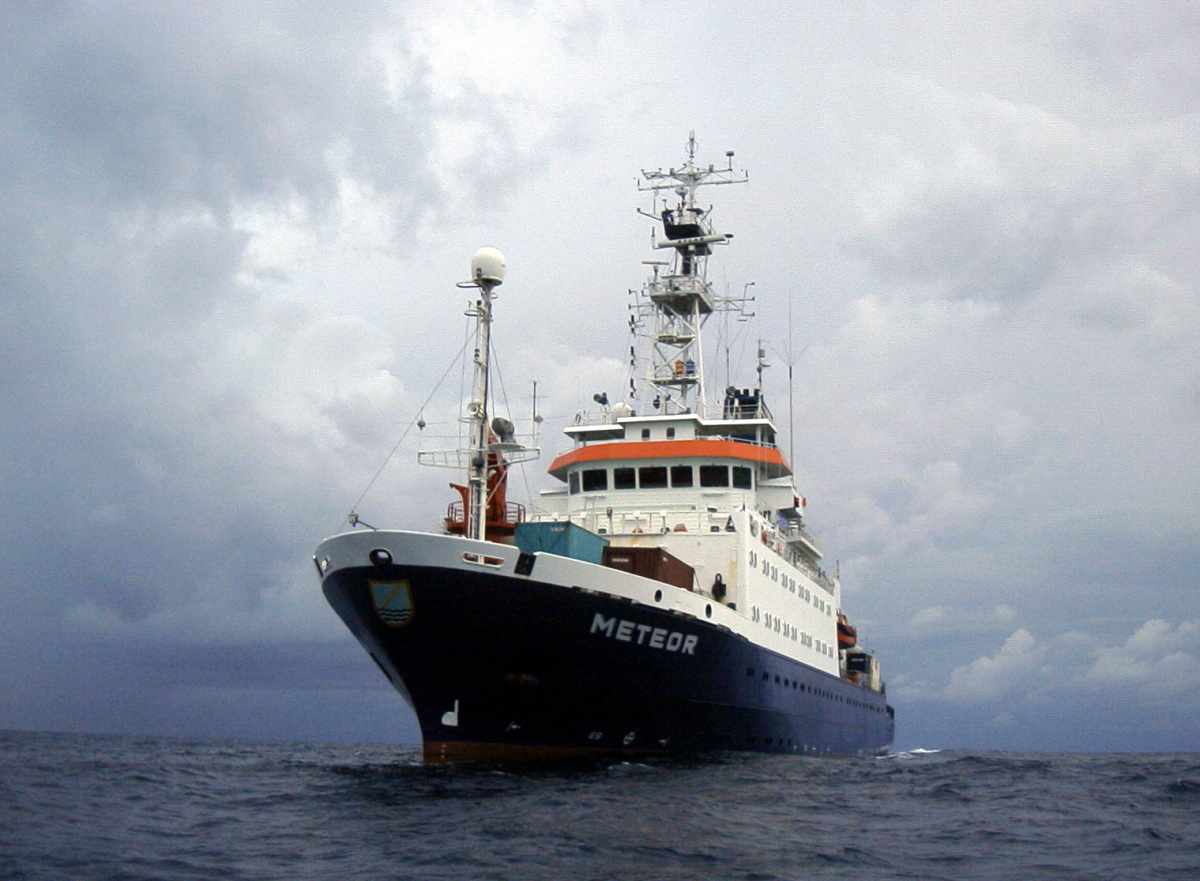Page path:
- Press Office
- Highlights 2000 - 2011
- Anammox Bacteria produce Nitrogen Gas in Oceans...
Anammox Bacteria produce Nitrogen Gas in Oceans´ Snackbar
Thirty to fifty percent of the global conversion of nutrients to nitrogen gas occurs in these areas. In ‘The Proceedings of the National Academy of Science of the United States (PNAS)’ of Tuesday 19 April, researchers from Bremen and Nijmegen state that this conversion is not carried out by denitrifying bacteria, as was believed for decades, but by anammox bacteria. Nitrogen compounds act as fertilizers and are the ecological basis for any lifeform on earth as these compounds limit the overall growth rate.
The researchers discovered this type of bacteria for the first time a few years ago in the oxygen poor Black Sea and now also in the open ocean. This discovery has major consequences for our understanding of the global nitrogen cycle. The Benguela current system leads to upwelling of nutrient-rich cold water off the coast of Namibia and acts as a kind of snackbar in the tropical ocean, which is visited by many animals including giant whales. The newly discovered anammox bacteria remove ammonium from the ocean, which as a result can not be taken up anymore by other organisms. Algae and cyanobacteria only partly succeed in fixing the released nitrogen gas to form new nutrients that can be fed into the nutrient cycle again.
The researchers discovered this type of bacteria for the first time a few years ago in the oxygen poor Black Sea and now also in the open ocean. This discovery has major consequences for our understanding of the global nitrogen cycle. The Benguela current system leads to upwelling of nutrient-rich cold water off the coast of Namibia and acts as a kind of snackbar in the tropical ocean, which is visited by many animals including giant whales. The newly discovered anammox bacteria remove ammonium from the ocean, which as a result can not be taken up anymore by other organisms. Algae and cyanobacteria only partly succeed in fixing the released nitrogen gas to form new nutrients that can be fed into the nutrient cycle again.
The Anammox cells under the fluorescent light microscope. The specific gene probe stains only the anammox cells (right panel). Total microorganisms are visible on the left.
In the article in PNAS, researchers from the Max Planck Institute for Marine Microbiology (Bremen, Germany) and the Institute of Water and Wetland Research (IWWR) of the Radboud University of Nijmegen show for the first time that anammox bacteria are present in the Atlantic ocean in oxygen poor waters at ~100 m depth. The number and activity of anammox bacteria present at this depth is sufficient to remove the ammonium that rises up from deeper waters and the seafloor. A unique combination of microbiological methods involving high resolution nutrient profiles, experiments with stable isotope labeled nutrients, depth profiles of unique membrane lipids (ladder molecules), fluorescence microscopy and DNA analyses of water samples was used to proof the abundance of anammox bacteria in the Atlantic Ocean. The discovery of anammox bacteria in the open ocean has major consequences for our understanding of the global nitrogen cycle. Models of global nitrogen budgets, which play an important role in long term climate predictions, will have to be revised. The discovered nitrogen loss has also consequences for the carbon cycle in marine ecosystems.
Denitrification.
The measurements refute the dominating theory that oceanic nitrogen loss results from the activity of bacteria that convert nitrate (via nitrite) with organic matter to nitrogen gas in the absence of oxygen (denitrification). In fact, the researchers recently discovered that anammox bacteria can use organic matter to convert nitrate into nitrite (much better than denitrifying bacteria). This new finding even increases the importance of anammox bacteria in the ocean.
New species
The anammox bacteria discovered in the Atlantic Ocean are closely related to the bacterial species Scalindua sorokinii, which was recently discovered in the Black Sea (Kuypers et al., 2003 Nature 8 April). Like their relatives in the Black Sea, the Namibian anammox bacteria contain unique ladder molecules (Damsté et al., Nature 17 October 2002) in the membrane surrounding a special prokaryotic organel in which ammonium is converted to nitrogen gas. These ladder molecules are ether bound in the membrane. This property was believed to be restricted to the Archaea, the ‘ancient’ bacteria.
Waste water treatment
The anammox process, in which ammonium is oxidized with nitrite to nitrogen gas, is a promissing alternative to current methods of nutrient nitrogen removal from waste water. The running costs of a waste water treatment system using the anammox process are only 10% of the costs of current treatment systems using conventional methods. Additionaly, the anammox process could reduce the emission of the greenhouse gas CO2 during waste water treatment by 88%. Because of these advantages the first large scale waste water treatment system was recently installed in Rotterdam (The Netherlands).
Denitrification.
The measurements refute the dominating theory that oceanic nitrogen loss results from the activity of bacteria that convert nitrate (via nitrite) with organic matter to nitrogen gas in the absence of oxygen (denitrification). In fact, the researchers recently discovered that anammox bacteria can use organic matter to convert nitrate into nitrite (much better than denitrifying bacteria). This new finding even increases the importance of anammox bacteria in the ocean.
New species
The anammox bacteria discovered in the Atlantic Ocean are closely related to the bacterial species Scalindua sorokinii, which was recently discovered in the Black Sea (Kuypers et al., 2003 Nature 8 April). Like their relatives in the Black Sea, the Namibian anammox bacteria contain unique ladder molecules (Damsté et al., Nature 17 October 2002) in the membrane surrounding a special prokaryotic organel in which ammonium is converted to nitrogen gas. These ladder molecules are ether bound in the membrane. This property was believed to be restricted to the Archaea, the ‘ancient’ bacteria.
Waste water treatment
The anammox process, in which ammonium is oxidized with nitrite to nitrogen gas, is a promissing alternative to current methods of nutrient nitrogen removal from waste water. The running costs of a waste water treatment system using the anammox process are only 10% of the costs of current treatment systems using conventional methods. Additionaly, the anammox process could reduce the emission of the greenhouse gas CO2 during waste water treatment by 88%. Because of these advantages the first large scale waste water treatment system was recently installed in Rotterdam (The Netherlands).
Distribution of annual primary production in the ocean (source: http://marine.rutgers.edu/opp/swf/Production/results/all2_swf.html) and location of the Benguela upwelling system. The white box indicates the areal extent of the Benguela upwelling system.
Title of publication and authors:
Massive nitrogen loss from the Benguela upwelling system through anaerobic
ammonium oxidation
Marcel M.M. Kuypers*, Gaute Lavik*, Dagmar Wöbken*, Markus Schmid, Bernhard M.
Fuchs*, Rudolf Amann*, Bo Barker Jørgensen* & Mike S.M. Jetten
*Max-Planck-Institute for Marine Microbiology, Celsiusstraße 1, 28359 Bremen,
Germany Department of Microbiology, IWWR Radboud University Nijmegen,
Toernooiveld 1, 6525 ED Nijmegen, The Netherlands
More information on the anammox-process can be found on www.anammox.com
For more information on the anammox process you can call:
Dr. Marcel Kuypers, Max Planck Institute for Marine Microbiology, Germany, phone +49 421 2028634 (E-mail : [Bitte aktivieren Sie Javascript]).
Dr. Manfred Schloesser (Press spokesman)
Max Planck Institute for Marine Microbiology, Germany, phone +49 421 2028704 (E-mail : [Bitte aktivieren Sie Javascript]).
Alternatively
Prof. Dr. Ir. Mike Jetten, afdeling Microbiologie KU Nijmegen, of +31 24 365 2941 (e mail: [Bitte aktivieren Sie Javascript]).
Massive nitrogen loss from the Benguela upwelling system through anaerobic
ammonium oxidation
Marcel M.M. Kuypers*, Gaute Lavik*, Dagmar Wöbken*, Markus Schmid, Bernhard M.
Fuchs*, Rudolf Amann*, Bo Barker Jørgensen* & Mike S.M. Jetten
*Max-Planck-Institute for Marine Microbiology, Celsiusstraße 1, 28359 Bremen,
Germany Department of Microbiology, IWWR Radboud University Nijmegen,
Toernooiveld 1, 6525 ED Nijmegen, The Netherlands
More information on the anammox-process can be found on www.anammox.com
For more information on the anammox process you can call:
Dr. Marcel Kuypers, Max Planck Institute for Marine Microbiology, Germany, phone +49 421 2028634 (E-mail : [Bitte aktivieren Sie Javascript]).
Dr. Manfred Schloesser (Press spokesman)
Max Planck Institute for Marine Microbiology, Germany, phone +49 421 2028704 (E-mail : [Bitte aktivieren Sie Javascript]).
Alternatively
Prof. Dr. Ir. Mike Jetten, afdeling Microbiologie KU Nijmegen, of +31 24 365 2941 (e mail: [Bitte aktivieren Sie Javascript]).
Director
MPI for Marine Microbiology
Celsiusstr. 1
D-28359 Bremen
Germany
|
Room: |
3101 |
|
Phone: |

Picture gallery
From top to bottom
Gabi Klockgether from the MPI in Bremen, Germany, measuring nutrients.
Sampling the water column with the rosette system.
Marcel Kuypers and Gaute Lavik preparing the special filtration pumps for collecting the anammox bacteria.
German Research Vessel Meteor in the Southern Atlantic.
The fotos were taken by Dr. Volker Bruechert, scientist at the MPI Bremen.
Gabi Klockgether from the MPI in Bremen, Germany, measuring nutrients.
Sampling the water column with the rosette system.
Marcel Kuypers and Gaute Lavik preparing the special filtration pumps for collecting the anammox bacteria.
German Research Vessel Meteor in the Southern Atlantic.
The fotos were taken by Dr. Volker Bruechert, scientist at the MPI Bremen.





